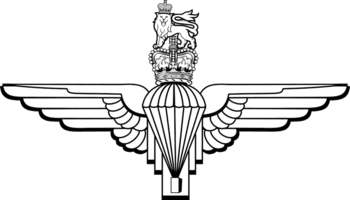 The Parachute Regiment, colloquially known as the Paras, is an elite airborne infantry regiment of the British Army. The regiment is one of the most elite units in the world.[5] The first battalion is permanently under the command of the Director Special Forces in the Special Forces Support Group. The other battalions are the parachute infantry component of the British Army’s rapid response formation, 16 Air Assault Brigade. The Paras are the only line infantry regiment of the British Army that has not been amalgamated with another unit since the end of the Second World War.
The Parachute Regiment, colloquially known as the Paras, is an elite airborne infantry regiment of the British Army. The regiment is one of the most elite units in the world.[5] The first battalion is permanently under the command of the Director Special Forces in the Special Forces Support Group. The other battalions are the parachute infantry component of the British Army’s rapid response formation, 16 Air Assault Brigade. The Paras are the only line infantry regiment of the British Army that has not been amalgamated with another unit since the end of the Second World War.
The Parachute Regiment was formed on 22 June 1940 during the Second World War and eventually raised 17 battalions. In Europe, these battalions formed part of the 1st Airborne Division, the 6th Airborne Division and the 2nd Independent Parachute Brigade Group. Another three battalions served with the British Indian Army in India and Burma. The regiment took part in six major parachute assault operations in North Africa, Italy, Greece, France, the Netherlands and Germany, often landing ahead of all other troops.
At the end of the Second World War, the regiment was reduced to three regular army battalions first assigned to the 16th Parachute Brigade and later the 5th Airborne Brigade. The reserve 16th Airborne Division was formed using the regiment reserve battalions in the Territorial Army. Defence cuts gradually reduced the TA formations to a parachute brigade and then a single reserve battalion. In the same time period, the regular army battalions have taken part in operations in Suez, Cyprus, Borneo, Aden, Northern Ireland, the Falklands, the Balkans, Sierra Leone, Iraq and Afghanistan, at times being reinforced by men from the reserve battalion.
Organisation
A soldier from the 3rd Battalion in Iraq in 2003, armed with an L85A2
The Parachute Regiment consists of three regular army battalions, the 1st, 2nd, and 3rd, and an Army Reserve battalion, the 4th. The 1st is based at St Athan, Wales, and is permanently attached to the Special Forces Support Group (SFSG)[nb 1] They receive further training on additional weapons, communications equipment and specialist assault skills. All men within the Parachute Regiment can expect to serve with the SFSG on rotation. This ensures that the advanced military skills taught to the SFSG are maintained in the other two regular battalions. The 2nd and 3rd battalions are the parachute infantry component of the 16 Air Assault Brigade, the army’s rapid response brigade, and are based at Colchester Garrison. The reserve 4th Battalion has its headquarters at Pudsey and companies in Glasgow, Liverpool and London.
Selection
Volunteers for the Parachute Regiment are invited to a 3-day insight course at the Parachute Regiment Assessment Course (PRAC) at Catterick Garrison. Over the three days, they have to pass a series of physical fitness assessments. All recruit training is then undertaken over a 30-week course with 2nd Infantry Training Battalion at the Infantry Training Centre at Catterick.
P company puts recruits through a number of physical assessments designed to test fitness, stamina and teamwork skills. At the end of P Company, recruits take part in eight pre-parachute selection tests. Those who are successful are awarded their maroon beret. Currently, recruits for the Parachute Regiment must be male and aged 16 to 33 for the regular Army, or 18 to 40 for the Army Reserve (4 PARA).[17] Potential Officers must be aged 18 to 29. After the British government removed the ban on women serving in Ground Close Combat (GCC) roles, women will be permitted to join all infantry units, including the Parachute Regiment and Royal Marines Commandos, by the end of 2018.
Sir Yes Sir Military Insignia provides most British Regiments Bespoke Rings, Cuff Links and Dog Tags. Furthermore, if we don’t have what you are looking for please visit out Custom Ring page and have us design exactly to your requirement.

